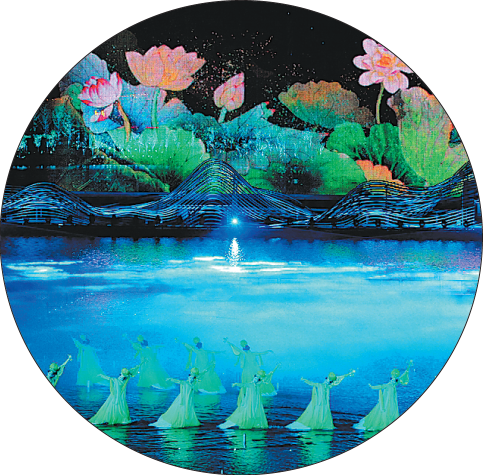Shanxi shines as beacon of culture and tourism
Updated: 2024-06-28
Province offers visitors myriad of world-renowned historical sites and natural wonders for enriching travel experience
From the gorgeous Yellow River gorges to the spectacular Taihang Mountains, from the Great Wall and the Yungang Grottoes to the ancient city of Pingyao, the North China province of Shanxi has some of the best sites in the country to offer to tourists.
As a famed tourist destination in China, Shanxi's unique charm is a perfect combination of natural wonders and cultural attractions. And in recent years, its appeal has been further enhanced with the integration of cultural and tourism industries, as well as the empowerment of modern and smart technologies.
The attractions of Shanxi as well as its latest development in culture-tourism integration and technological empowerment will be highlighted at the 10th Shanxi Tourism Development Conference to be held in the near future.
Shanxi is often referred to as biaoli shanhe by its locals, a term that literally means it is a land between the Yellow River and the Taihang Mountains.
The Taihang Mountains
The Taihang Mountains in the east of Shanxi are renowned for their precipitous peaks, steep cliffs, strange rocks, lush forests and clean waters.
Located in the southeast of Huguan county, Taihang Mountain Grand Canyon, for instance, is one of the 10 most beautiful canyons in China, because of its unique landforms and its rare animals and plants.
And the best part of this grand canyon is Baquan Gorge, or Eight Springs Gorge.
Known as the most imposing gorge in the Taihang Mountains, Baquan Gorge snakes its way along 13 kilometers of the middle section of the Taihang Mountain Grand Canyon scenic area, with altitudes from 600 to 1,400 meters and a maximum drop of 1,100 meters.
Home to more than 300 spring-heads and 30 waterfalls, the natural landscape of Baquan Gorge forms a delightful contrast with the modern world.
However, recent updates in tourism development are offering new and modern experiences to tourists in Baquan Gorge. In addition to traditional sightseeing and mountain climbing, tourists are offered a variety of options like cruise ship tours, transparent elevator sightseeing, camping, geological studies and a range of leisure tours.
Within the entire Taihang Mountains range, which stretches about 400 km from the north to the south, local tourism operators are trying their best to enhance tourist experiences by enriching service portfolio and integrating tourism with culture.
The Hushan Scenic Area in Licheng county rose to fame in 2023 as it was recognized by the China Forestry Industry Federation as a national-level forestry wellness base.
Wellness tourism is an emerging sector in the wider picture of traveling. It features travels associated with the pursuit of enhancing one's personal well-being. Wellness trips include a variety of activities such as thermal springs, spas, exercise, recreation, relaxation and recuperation.
Hushan is adjacent to the Huangyadong Scenic Area, a famed Red tourism site as it used to be an important base for the Eighth Route Army led by the Communist Party of China during the War of Resistance Against Japanese Aggression (1931-45).
After a day of visiting the revolutionary sites and seeing the impressive sights of the Taihang Mountains, the hot spring spas in the Hushan Scenic Area now offer a new, refreshing and relaxing experience to tourists.
In the county of Pingshun, also in the Taihang Mountains, there is a tourist destination called the Taihang Riverside Town, which has seen its fame rising in recent years. Stretching about 50 km along the Zhuozhang River, the tourist destination is a combination of natural wonders and cultural assets.
The Zhuozhang is a large river in North China originating from the Taihang Mountains. In the scenic area in Pingshun, the river starts its journey as murmuring springs and brooks flowing out of deep valleys. It becomes a torrential stream in the lower reaches until it is tamed by a huge reservoir. After flowing out of the reservoir dam, the river presents an outlook similar to those in the south of the Yangtze River, with flocks of ducks and wild birds floating on the tranquil watercourse, both banks shaded by rows of willow trees and ancient villages scattered along the waterway.
With such advantageous resources, the local authorities are planning to develop the Taihang Riverside Town into an ecological and cultural tourism destination with both national and international fame.
In addition to Baquan Gorge, Hushan and the riverside town, there are numerous sites in the Taihang Mountains that are offering worthwhile tours for visitors to tap into natural wonders and local lives and cultures.
The Taihang Mountains are a source of pride for the people of Shanxi because it is where the name of Shanxi province comes from. Shanxi – which means "to the west of the mountains" – is called so because it is located to the west of Taihang.
The Yellow River
Also boasting a similar cultural significance is the Yellow River. In ancient times, Shanxi was called Hedong, which means "to the east of the (Yellow) River".
The Yellow River marks both the western and southern borders of Shanxi. But in the west of Shanxi, the river has a course much longer than that in the south.
The Yellow River is the mother river of China. It has nurtured the culture and economy of the nation for thousands of years. In Shanxi, the river has ushered in a farming culture lasting around four millennia, making it one of the sources of Chinese civilization.
If there is one destination that visitors should not miss when touring the Yellow River, that is the Hukou Waterfalls, a site where people can feel the mighty force of the river.
Located in an area bordering Jixian county in Shanxi province and Yichuan county in Shaanxi province, it is the second-biggest waterfall in China. It is also the most spectacular yellow waterfall in the world.
After finishing a journey of about 3,500 km from its source in Qinghai province, the Yellow River enters Shanxi province in Pianguan county. From there, it serves as the border of Shanxi and Shaanxi provinces and starts a journey of 725 km between the mountains of both provinces. This section is called Jinshan- or Shanxi-Shaanxi – Grand Gorges, which was rated as one of the top 10 beautiful gorges in China in 2005.
When the Yellow River flows through the gorges, it becomes torrential, as its course is restricted by the gorges and narrows to a width of about 300 meters.
In Hukou, the water course further narrows to about 50 meter, falling more than 20 meter into a deep riverbed. The tremendous mass of water strikes the rocks, creating piles of foam, a shroud of mist and a thundering sound that can be heard from miles away.
Hukou, which means kettle spout, is so named because the waterfall resembles an enormous kettle spout with rushing water pouring down.
At Hukou, the water falls to the deep riverbed, stirring the mist which rises high into the air like heavy smoke surging from the river. Tourists can see various shapes of rainbows formed by the rising mist, refracted by the sunshine from different angles.
The water in Hukou is extremely powerful, so the boats from the upper and lower reaches must be pulled out of the river and onto the bank when they arrive. These boats will have to detour around this section, carried by trucks or tractors, before they can be put into the river again.
The Hukou Waterfalls, as a bottleneck to the navigable Yellow River, have also led to a prosperous transshipping business in several locales in its upper and lower reaches since ancient times.
One such locale is the ancient town of Qikou in Linxian county, on the upper stream of the Hukou Waterfalls.
Historical records state that it reached the peak of its prosperity during the Ming (1368-1644) and Qing (1644-1911) dynasties as a transport hub for the renowned Shanxi merchants.
It is said the Shanxi merchants – or Jinshang – dominated commercial circles for more than five centuries by trading with regions in North Asia and Europe.
Qikou, which literally means "port by a torrential river", is located on the eastern bank of the Yellow River.
In the past, the Shanxi merchants used the Yellow River as a channel to transport cargo. However, cargo ships were disrupted by the Qikou Torrent, as well as the Hukou Waterfalls.
To solve the problem, a transshipment port was developed in Qikou. Receiving more than 150 ships a day at its peak, Qikou became a transportation hub for the Shanxi merchants.
Home to more than 400 companies during that period, Qikou was called the "No 1 town by the Yellow River".
In modern times, with highways and railways taking over the Yellow River as the major means of transport, the town has developed into a destination for tourists. Major attractions in the town include well-preserved historical residences, commercial properties, piers and temples.
Nowadays, tourists to Qikou can also have a deeper understanding of the ancient town and the Shanxi merchants with the help of a live show called Dreamy Qikou, showing how the ancient town achieved prosperity in different historical periods.
While the Yellow River has nurtured the culture and economy in Shanxi, it has on occasion brought disasters to the region throughout history, as it destroyed land and properties and even took lives during severe floods.
Improving environment
For millennia, the residents in Shanxi have come to a consensus that the improvement of the Yellow River is crucial to the well-being of the region and the entire nation. But it was only in recent decades that they realized that curbing soil erosion and improving the environment can eventually change the river for the better.
As Shanxi is located on the Loess Plateau, soil erosion has been a challenge to the Yellow River for thousands of years. In the early 1950s, the area of soil erosion in Shanxi was 108,000 square kilometers, of which 67,600 sq km was in the Yellow River drainage basin.
Shanxi has implemented campaigns to curb soil erosion and improve the environment for the Yellow River and its tributaries in recent decades. By the end of 2022, about 56 percent of the land suffering soil erosion had been curbed. In the 1950s, nearly 70 percent of Shanxi's total area was subject to soil erosion.
The improvement in the environment is made possible with the locals' greening efforts.
The Fenhe River, for instance, is the largest tributary of the Yellow River in Shanxi and is known as the mother river of the province.
The Taiyuan section of the Fenhe River stretches 188 km, with 43 km passing through the urban area. This river is now a point of pride for the people in Taiyuan, the capital city of Shanxi province, as it is a scenic belt that draws in millions of visitors every year and an ecological corridor protecting the environmental well-being of Taiyuan.
The Fenhe was a scenic river in historical times with eight famed scenic attractions in its Taiyuan section. However, it lost its historical glory in the last century as a result of environmental deterioration – growing industrial pollution and decreasing vegetation coverage.
Changes began to take place in the 1990s, when Taiyuan launched environmental improvement projects for the river, with local authorities focusing their efforts on controlling pollution, greening the land and increasing water supply to the river.
As a result, the river has regained its charm in recent years. In Taiyuan, the river is surrounded by more than 30 forest parks.
The Fenhe River scenic belt has now formed a pleasantly unique ecosystem for both humans and wildlife. More than 230 varieties of plants have been growing along the river, and the pedestrian paths and the cycling roads have helped to make the area increasingly appealing as a place to relax, exercise and see the sights. The wetlands along the river are also the habitat for more than 160 species of wild birds.
New landscaping projects have also been developed along the river, with 23 bridges across the rivers becoming new landmarks of the city.
Another valuable asset that Shanxi people can take pride in is its rich historical and cultural legacy.
Cultural legacy
The region is widely recognized as one of the cradles of Chinese civilization and this reputation is supported by the rich varieties of historical relics discovered in the province.
Archaeological discoveries in recent decades show that the Xihoudu site in Ruicheng county is the earliest known site dating to the early Paleolithic Age – some 2 million years ago – in China. Antlers with cuts and burned animal bones unearthed from the site are the earliest evidence of human use of fire in China.
The Taosi site in Xiangfen county points to the earliest establishment of the 24 zodiac terms some 4,000 years ago with 13 compressed earth columns discovered and identified as observation tools used to measure the sun's beam angle and determine the 24 zodiac terms of a year.
Benefiting from a rich wealth of historical relics, Shanxi is now one of the national leaders in the number of tangible cultural heritage items.
Shanxi province is always remembered by tourists from all across the world for its three World Cultural Heritage sites – Yungang Grottoes, Mount Wutai and Pingyao Ancient City, as well as its 531 places recognized as relics sites on the national list of protection.
Shanxi is indeed one of the worthwhile destinations in China for tourists to tap into the brilliant past of the nation. And in recent years, tourists' understanding of its history and culture has been further enhanced with digital technologies and culture-tourism integration projects.
The emerging live shows in popular tourist destinations such as Jinyang Lake, Mount Wutai, and Pingyao Ancient City are prime examples of culture-tourism integration, which helps tourists better understand Shanxi with vivid presentations.
The famed World Cultural Heritage site of Yungang Grottoes in Datong city, has made its new efforts to reach people in the wider world with the empowerment of 3D printing and high-fidelity digital technologies.
Since the first mobile 3D-printed 1:1 replica cave of the Yungang Grottoes made its debut in June 2020 at the Museum of Art and Archaeology in Zhejiang province, the cultural heritage site has been accessible for a wider range of audiences worldwide, both online and offline.
In addition to digitalization, the substantial improvement in infrastructure is also playing a crucial role in increasing Shanxi's appeal to tourists at home and abroad.
Over recent years, Shanxi has built three sightseeing highways to link to scenic sites along the three landmark attractions of the Yellow River, the Taihang Mountains and the Great Wall. A total of 112 scenic sites at or above the national A level, 315 sites below the A level and 508 rural tourism sites have benefited from this project.
Li Yao contributed to this story.

From left: Taihang is one of the most spectacular mountain ranges in North China. The Sakyamuni Pagoda is the largest and oldest wooden structure in the world. The Tianlong Mountain is an example of the greening efforts in the city of Taiyuan. Provided to CHINA DAILY

The live show staged in the Jinyang Lake scenic area is an example of culture-tourism integration in Shanxi. Provided to CHINA DAILY

The maiden statue in Taiyuan's Jinci Temple was crafted in the Song Dynasty (960-1279). Provided to CHINA DAILY

The colorful standing statues in the second cave are one of the highlights of the Yungang Grottoes in Datong. Provided to CHINA DAILY

From left: The Great Wall is one of the landmark attractions in Shanxi along with the Yellow River and Taihang Mountains. Cruise ship tours are a new option for tourists in Baquan Gorge. The Fenhe River has evolved into an attractive scenic belt in Taiyuan in recent years. The Hukou Waterfalls show the mighty force of the Yellow River in summer when its runoff is at its peak. Provided to CHINA DAILY

